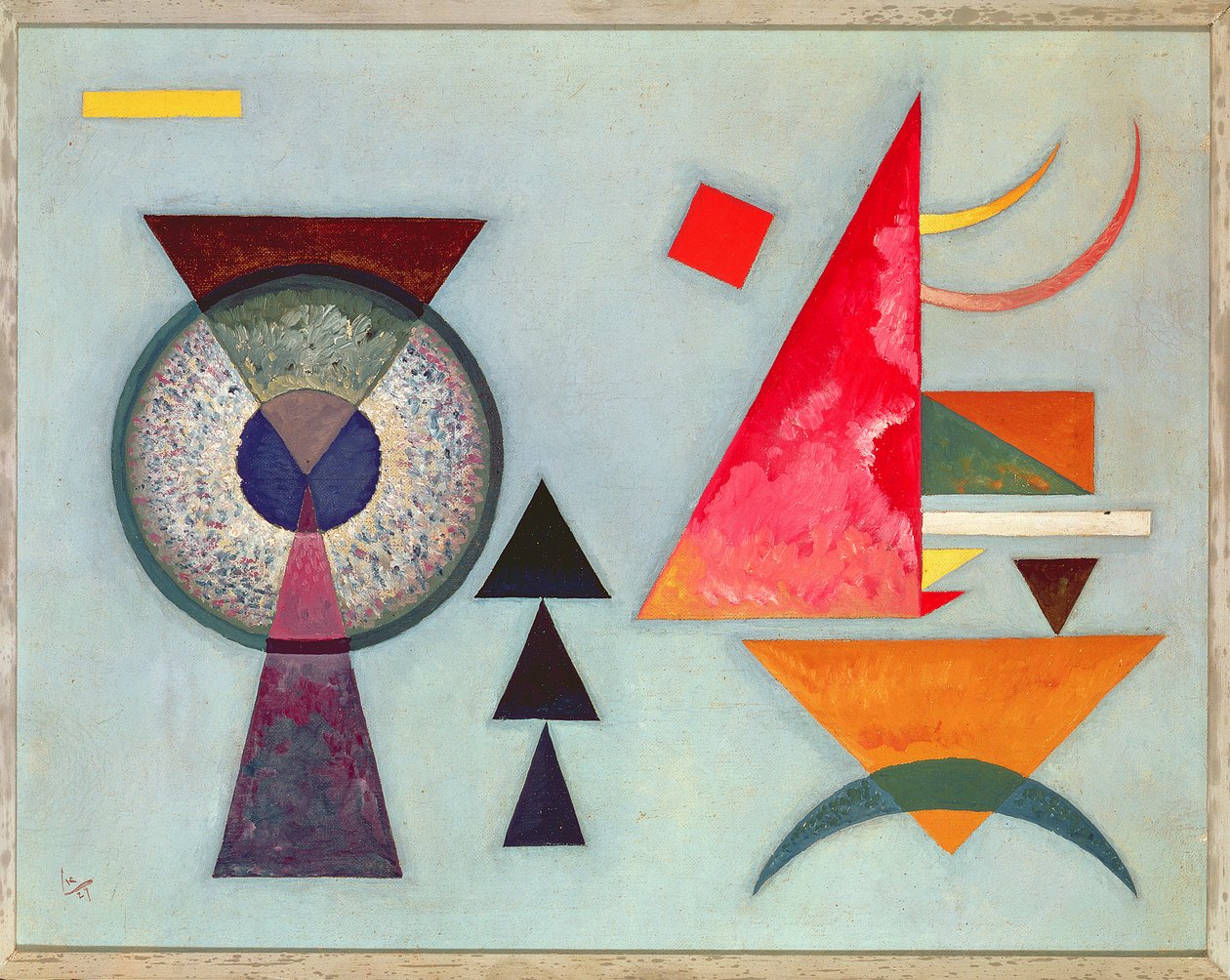1927 · Öl auf Leinwand
· Picture ID: 39363
Expressionism
· Abstract Forms
With “Weiches Hart”, the Russian painter Wassily Kandinsky (1866 - 1944) created a work of unprecedented explosiveness. It was last seen in the villa of a Weimar art dealer who was murdered during a burglary. Fortunately, the drama only happened in the TV fiction of the "crime scene". However, the picture itself also has a dramaturgy, namely of colors, shapes, their contrasts and similarities.
Organized image composition
In contrast to Kandinsky's energetic, tense works from the 1920s, “Weiches Hart” appears organized and calming. The composition appears balanced due to the skilful incorporation of horizontal and vertical. The free sickle shapes and the circle ensure a subdued dynamic. Overall, the impression of well thought-out conditions prevails.
Basic colors and basic shapes
In his function as a Bauhaus teacher (from 1922) Kandinsky concentrated on the basic colors red-yellow-blue and the basic forms of circle-triangle-square. We also find these components in the “Soft Hard” composition, although in variations. As if divided by an invisible border, the blue and cool elements are on the left, the red and yellow (warmer) elements on the right. Despite this apparent incompatibility, the artist strives to compromise. Through mutual penetrations, he solves the color conflict and creates a well-proportioned overall result. This is shown by the yellow bar on the blue-cool half or the blue triangle and sickle on the yellow-red-warm half.
Kandinsky and Klee
A slight relationship with similar works by Paul Klee (1879 - 1940) cannot be denied. This is no coincidence, because both worked as teachers at the Bauhaus and dealt intensively with basic colors and basic shapes. There was a friendly relationship between the two artists. Even more: Klee saw the Russian artist as a "friend and teacher". Regardless, the 13-year-old Kandinsky may have "seen" one or the other from Klee. In particular, the coordinated interaction of colors and shapes, as we find it realized in "Soft Hard".
Contrast of forms
"Soft hard" - this title alludes to the shape of the picture. The attribute "soft" primarily comes from the circle on the left half of the picture. Although it is not placed in the center, thanks to its exclusivity it represents a kind of center. In contrast, the triangles, rectangles and, to a certain extent, the sickles appear hard and pointed. With a lot of good will, the circle and inner circle could be interpreted as an eye. As is well known, Kandinsky avoided such attributions. In the reality of the work of art, the geometric figures and colors exist only for themselves. Whether the painter unconsciously envisioned a portrait, a group of figures, a landscape or a building - who can say that?
Soft Hard by Wassily Kandinsky. Available as an art print on canvas, photo paper, watercolor board, uncoated paper or Japanese paper.
blaue reiter ·
blue four ·
abstract ·
triangle ·
circle ·
crescent
· Galerie Maeght, Paris, France / Bridgeman Images
|
×




.jpg)
_-_(MeisterDrucke-1526182).jpg)
.jpg)
.jpg)
.jpg)
.jpg)
.jpg)
.jpg)
.jpg)
.jpg)
.jpg)
.jpg)
.jpg)
.jpg)
.jpg)
 - (MeisterDrucke-110110).jpg)
.jpg)
.jpg)
.jpg)
.jpg)
.jpg)
.jpg)
.jpg)
.jpg)
.jpg)
.jpg)
.jpg)
.jpg)
.jpg)
.jpg)
.jpg)
.jpg)
.jpg)
 - (MeisterDrucke-103908).jpg)
.jpg)
.jpg)
.jpg)
.jpg)
_1936_-_(MeisterDrucke-803920).jpg)
.jpg)
 1922 - (MeisterDrucke-647283).jpg)
.jpg)
_-_(MeisterDrucke-40854).jpg)
.jpg)
.jpg)
.jpg)
.jpg)
.jpg)
 - (MeisterDrucke-50605).jpg)
_-_(MeisterDrucke-376543).jpg)
.jpg)
.jpg)
.jpg)
.jpg)
.jpg)
.jpg)
.jpg)
.jpg)
.jpg)
_-_(MeisterDrucke-636266).jpg)
.jpg)
.jpg)
.jpg)
.jpg)
.jpg)
.jpg)
.jpg)
.jpg)
.jpg)
.jpg)
.jpg)







